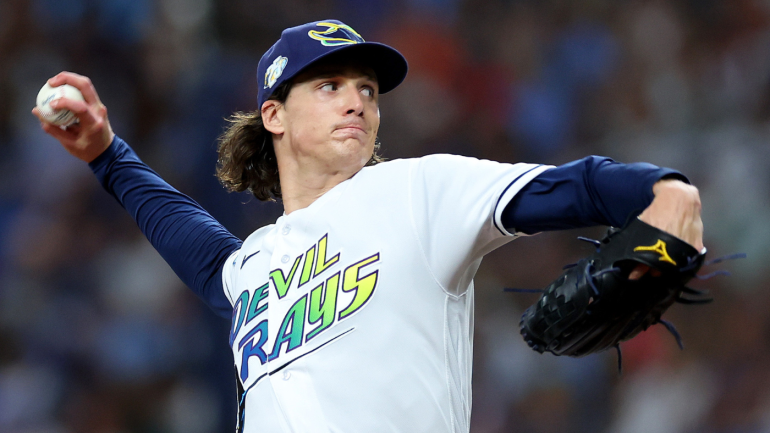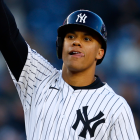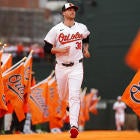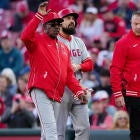
The Los Angeles Dodgers and Tampa Bay Rays agreed to a blockbuster trade on Wednesday, headlined by right-hander Tyler Glasnow. The Dodgers will also receive outfielder Manuel Margot in exchange for right-hander Ryan Pepiot and outfielder Jonny Deluca. The deal was contingent on Glasnow agreeing to an extension with the Dodgers, something he reportedly did on Friday morning. Glasnow will be guaranteed four years and $110 million in new money with a club option worth $30 million for the 2029 season that, if declined, converts to a $20 million player option.
For the Dodgers, it's a splashy follow-up move to the weekend signing of Shohei Ohtani. For the Rays, it's a way to relieve financial tension without punting on their chances of competing next season. We here at CBS Sports are nothing if not judgmental. As such, we've gone ahead and rendered an instant verdict on both sides of this deal.
Here, again, is the trade in whole:
- Dodgers receive: RHP Tyler Glasnow, OF Manuel Margot, $4 million
- Rays receive: RHP Ryan Pepiot, OF Jonny Deluca
Now, let's get to the gasbaggery.
Dodgers grade: A
The first half of the Dodgers offseason revolved around their recruitment of two-way superstar Shohei Ohtani, the organization's white whale. They landed him on Saturday, agreeing to terms on a 10-year pact worth $700 million (but not really) that shattered every contract-related record in pro sports history. The rest of the Dodgers winter will be focused on onboarding arms, as a recent elbow surgery will keep Ohtani off the mound until 2025.
As it stands, Glasnow joins a group that is set to also feature the returning Walker Buehler, Bobby Miller, and some combination of internal options and yet-to-be-acquired veterans. There's still a little work to be done, with the Dodgers rumored to be among the top suitors for Yoshinobu Yamamoto.
Glasnow's appeal is easy to understand. He's one of the game's fiercest pitchers when he's healthy. Over the last three seasons, he ranks 18th in ERA+ (ahead of former teammates Shane McClanahan and Blake Snell), second in strikeouts per nine, and 15th in strikeout-to-walk ratio among starters. The catch, and the downside with Glasnow, is that last season's 120-inning effort represented a new career-high in workload, as well as just the second time he's cleared the century mark. To paraphrase an old Chuck LaMar quote: the only thing separating Glasnow from a Cy Young Award is a full season of starts.
Whether or not Glasnow ever starts 30 times (or, heck, 25 times) is to be determined by the Powers That Be. However many starts he takes in a season, he's likely to deliver good performances on the strength of a three-pitch arsenal that's built around verticality. Plot his pitches on a grid and they form a tower of doom at the y axis. He's got something nasty waiting for batters at the second story, the main floor, and in the basement.
Tyler Glasnow's 12th, 13th and 14th Ks.
— Rob Friedman (@PitchingNinja) September 7, 2023
Thru 6. 😳
'Now I am become Death, the destroyer of worlds.' pic.twitter.com/OFU2sO6svF
Glasnow's 96 mph plays faster thanks to an absurdly deep release point (he lets loose about seven and a half feet from the pitching rubber) and has a nearly perfect amount of backspin, creating a "rising" illusion. His 90 mph bullet slider is one of the hardest in the majors and goes down instead of sweeping across; and his signature curveball generated the third-highest percentage of whiffs (almost 52%) while featuring tons of depth.
But, while Glasnow is the headliner here, let's not ignore Margot's inclusion. He's an above-average defender in a corner who can slot into center as needed. He's also been a better hitter for his career against lefties than righties. That combination makes him a logical platoon partner with either James Outman or Jason Heyward, depending on what the Dodgers fancy on a given night.
Margot, then, is the "safe" part of the return. Barring an injury, he's going to give the Dodgers the advertised product and that's it. Conversely, the risk-reward component of Glasnow's game is clear. You take what you get, even if it means his $25 million salary works out to more than a million per start, because what you get from him is better than what you get from most. It will be interesting to see what the Dodgers have in mind to keep him healthy.
Looking for more Glasnow trade coverage? CBS Sports' Fantasy Baseball Today podcast has you covered with an emergency episode:
The Dodgers are well-positioned to take financial risks, as they're doing with the extension. Glasnow's deal -- with the 2024 money and player option locked in -- check in close to Carlos Rodón's six-year pact worth $162 million signed last winter. We find that to be a worthwhile comparison since Rodón had a similar profile: undeniable stuff and results with lingering questions about his durability (though he had started 55 times in the preceding two seasons). If you find that comparison valid, then this is right in line with what Glasnow could've reasonably expected to fetch on the open market.
For reference, the Rays kept Glasnow under 100 pitches in 18 of his 21 starts last season, presumably in an effort to keep him hearty and hale. Maybe Los Angeles intends to do the same, or to leverage its starter depth to run out a six-man rotation at times (or at least skip over Glasnow's starts on occasion). The Dodgers have some experience handling injury-prone pitchers. By coincidence or design (and we suspect the latter), Clayton Kershaw made between 22 and 24 starts in each of the last three years. He got hurt anyway and will miss at least a chunk of next season.
That's life for you. Laughs stop, wine dries, and money evaporates. The end is always closer than you think, and every thought about its encroachment brings you ever closer to it. That doesn't have to be a bad thing. Sometimes the end is punctuated by a parade. The Dodgers, with Ohtani and Glasnow (and yes, Margot) in tow, are setting themselves up to experience the good kind of conclusion -- in 2024 and beyond.
Rays grade: A
The dirty secret about baseball trades is you can divine, with a startling high degree of accuracy, how people will react based only on the teams involved. When the Rays are one of those clubs, you can be certain there will be takes about how they never lose trades. That's untrue. Every team loses trades, the Rays included. Trade returns are based on a combination of variables, including leverage. When you're the same team that spent nearly as much money on Opening Day payroll in 2000 as you did in 2021, coming off an American League pennant, you're going to have trouble convincing other clubs that, actually, you're OK keeping this player's escalating salary on the books.
In other words, the Rays are particularly vulnerable to making a suboptimal trade when their deals are motivated by their self-imposed financial restraints. Top executive Erik Neander tried his best to convince teams he might hold onto Glasnow and his $25 million salary next season. Did anyone really buy it? We doubt it, but you have to credit Neander for trying -- and, more importantly, for landing a better return than we would have reasonably expected considering that every team should've known better about their intentions. (We're joking here, but maybe Andrew Friedman sympathized given his own share of budget-trimming deals in sunny St. Pete?)
Pepiot is a fitting inclusion in a Glasnow trade if only because he too has durability issues. Dating back to his collegiate days at Butler, he's cleared the century mark twice in six tries. (He threw 101 innings in 2021 and 127 in 2022.) He's about to enter his age-26 season, meaning it's fair to question if he's ever going to turn into someone you can rely upon for 25-plus starts a season.
Ryan Pepiot's 8th and 9th Ks.
— Rob Friedman (@PitchingNinja) September 26, 2023
16 whiffs on his changeup. 😯 pic.twitter.com/trkq5WDGXX
Anyway, as with Glasnow, you live with the concerns about Pepiot's availability because of what he does when he is on the mound. In 78 big-league innings to date, he's amassed a 2.76 ERA and a 2.50 strikeout-to-walk ratio. Pepiot lacks Glasnow's physicality and eye-popping stuff, but he has two above-average pitches and the ability to get far down the mound, causing those pitches to play up more. He threw his mid-90s rising fastball about half of the time, with his 86 mph sidespinning changeup serving as his top secondary offering. He also chucks an upper-80s cutter/slider against right-handed batters that missed as many bats as the cambio.
The piece of intrigue here is whether or not the Rays can out-optimize the Dodgers on Pepiot, perhaps by altering his pitch mix. Tampa Bay has had success with other pitchers who looked like middle-of-the-rotation starters with other clubs -- Jeffrey Springs, Drew Rasmussen, and even Glasnow -- but the Dodgers might be the best in class at this kind of stuff. We'll find out.
Deluca, 25, is a reasonable replacement for Margot as a contact-orientated outfielder capable of standing at any of the outfield positions. He made his big-league debut last season, slashing .262/.311/.429 in 45 trips to the plate.
Again, you might think the Rays intend to unlock something, maybe tapping into raw strength or just having Deluca pull the ball more. It's not apparent that either tweak would add much. Deluca recorded just one batted ball last season, either in the majors or the minors, that cleared 110 mph. His big-league max, of 102.6 mph, would've ranked last -- behind even Tony Kemp and Luis Arraez -- had he qualified. As for the other part of the equation, he already pulled more than 53% of his batted balls, a percentage that would have ranked fifth in the majors among qualifiers (ahead of new teammate Isaac Paredes, who has pulled the ball to great effect despite so-so exit velocities).
Perhaps the straightforward way of thinking about this deal from the Rays' perspective is that they traded Glasnow and Margot for players who can get them most of the same output for far less money. That's not, within itself, an admirable or applaudable endgame for a ballclub -- you'd rather see a team fresh off a 99-win campaign (and $600 million in public funding for a new stadium) prioritize talent level above all -- but that's life for Neander and the Rays front office.






















